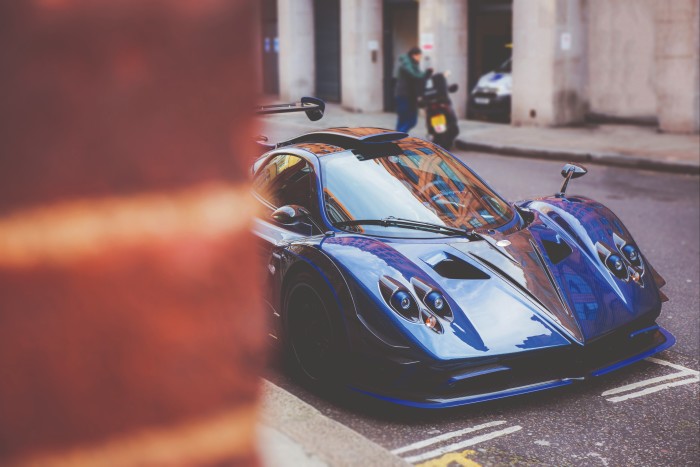the potential investment gains are attracting the attention of the super-rich

In a car showroom in London, high-end car dealer Joe Macari is in full flow. “It’s a piece of art,” he says, of the gleaming McLaren F1, the centrepiece of more than £100mn worth of classic and modern cars.
Unhitching the VIP rope, he pushes a button near the car’s rear wheel arch. The door unhinges up and out from the body, like a bat unfurling a wing. “But it’s a piece of art you can drive on a Sunday morning,” he says, with a twinkle in his eye.
The F1 is part of a production run of 106 that started in 1992. The model is considered by many as the world’s first hypercar — a moniker applied to a small group of elite vehicles, made by some of the world’s most celebrated sports-car makers, and several you have probably never heard of.
The cars are built to racetrack specifications, but — with features such as soundproofing, internal passenger seats and (albeit tiny) luggage compartments — sold to be driven on the road.
Besides their race-car speeds, hypercars also offer those rich enough to afford the typically £2mn-plus price tags the lure of striking looks, peerless engineering bloodstock, and the opportunity to be part of an exclusive group of owners, ensured by tightly limited editions.
Another attraction is their potential to increase in price, confounding the rule that new cars depreciate the moment they leave the showroom.
In recent years, the most sought-after examples, delivered to a handful of favoured clients, have been offered for resale at premiums exceeding 50 per cent, before the first has even been constructed. Many of the most bankable are made by Ferrari. But the McLaren F1, built between 1992 and 1998, and sold at the time for £541,00 plus taxes, would today set you back around £15mn.
“I’ve made at least 40 per cent [profit] on my collection,” says one hypercar owner, based in the Middle East, who has a large share in a family conglomerate and owns several businesses in real estate and other sectors.
He has been collecting cars since his late teens and has eclectic taste. “Off-roaders, classics, large wheelbase vehicles — my Mini Cooper still puts a smile on my face,” he says. But his hypercars are the crown jewels. “It’s something about the experience of driving at speed.”
He bought his first, a Ferrari Enzo, in 2007. Soon after, he added a Mercedes-Benz SLR McLaren and a Bugatti Veyron — at the time, the world’s most expensive production car.
In all, he has owned 19 hypercars — among them models from most of the leading manufacturers, including Ferrari’s LaFerrari, two Porsche 918 Spyders, two Paganis, a McLaren P1, and three Koenigseggs.
Today, he is considering buying a Gordon Murray, the eponymous new brand launched by the chief designer of the McLaren F1.

“My biggest gain was on a Pagani Zonda, which I bought for $1.68mn and sold for $4mn,” he says, of the Italian company’s model, which was produced until 2019. One of the Koenigseggs he owns, which he bought for $2.2mn, is now worth between $5.5mn and $6mn, he estimates.
His biggest regret, however, was passing up a McLaren F1 offered to him for $3mn in 2014. Instead, he spent the same amount on a Bugatti Chiron Super Sport.
“I thought it was a safer bet: a new car, fewer made than the McLaren, the top speed in the world at the time, and it looked great,” he says.
Five years later, on a tour of the McLaren factory in Woking, England, he recognised the car he had rejected, which had just changed hands for $14mn. In 2018, he sold the Bugatti, which had failed to capture the imagination of owners or critics, despite its speed, for $2mn.
“You win some, you lose some,” he reflects.
Thanks to growing numbers of global super-rich and a long period of ultra-low interest rates, the ranks of hypercar owners have grown in recent years.
James Banks, who was head of bespoke cars at McLaren until 2019 and now runs LaSource Automotive, a hypercar broker, estimates that, 20 years ago, there were no more than a few hundred people in the world with the means and desire to buy a hypercar. “Today, there are several thousand,” he says.
In 2020 and 2021, cheap money and sharp gains in equity sectors such as technology left the super-rich flush with cash, while pandemic restrictions cut off many from their favourite hobbies. Helped by news of hypercars’ investment gains — much of it published on social media by owners, brokers and enthusiasts — a large number of new rich buyers entered the market, sending valuations to record levels.
“We had a lot of new customers with access to money who were not car people,” says Macari. “They were thinking: my friend has one and it’s gone up 20 per cent in price, I’d like some of that.”
Hypercars have the potential to increase in price
40%
The average new car loses 40 per cent of its value in the first year, according to the AA, a UK motoring association
3700
A low-mileage McLaren F1, has appreciated 3,700 per cent, since it was released between 1992 and 1998
£2mn
For those who can afford the typical price tag of a hypercar, the prize is to be part of an elite group, ensured by tightly limited editions
Price rises were highly selective, though, favouring Ferraris and other cars that had been in the limelight and were instantly recognisable. “The price of a pristine, low mileage Ferrari F40 increased from £1.1mn to about £2.1mn in two years,” he says.
Other models hardly budged. “Koenigseggs appreciated less; Aston Martins were basically flat,” Macari explains. He gestures to a gleaming black 1967 Lamborghini Miura, parked near the McLaren. It was the fastest production road car at the time, and the first non-racing car to feature two seats with the engine in the rear — a design which became the hypercar template.
“But it’s an enthusiast’s car, so it was ignored,” he says. “[New investors] were only after certain cars in each group.”
For Banks, the emergence of hypercars as a financial asset goes back to 2015. “The right car became seemingly a concrete investment; people were selling cars off-plan, just from a concept sketch,” he says.
The gains on offer to those fortunate to secure a “slot” on the list of a favoured new hypercar can be huge, with many cars changing hands for steep premiums before they are even delivered. For example, Ferrari’s latest, the Daytona SP3, a run of 599, is priced at £1.7mn, and all have been sold, according to the company. “I could sell one tomorrow for between £3mn and £4mn,” says Richard Hawken, of EMM, which he describes as a private office for collectable car owners. “It’s free money, basically.”
New editions by Porsche are also highly sought after, as are those of Bugatti, Lamborghini and Pagani.
For buyers to be included on the list, they usually require a long-standing record of purchasing hypercars.

In recent years, many collectors have focused more on low-mileage cars, which command a steep premium, over other examples. “The trend started in the US, where the biggest collections are; you’ve seen it come over to Europe in the last five to seven years,” says Macari.
“The biggest damage to value is mileage — a lot of these cars never see the road,” says Dietrich Hatlapa, founder of Historic Automobile Group International, which produces an annual classic car index that includes hypercars. In some countries, keeping a car off the public highway can mean big savings. In Denmark, for example, the road-use registration tax on the portion of a car’s value greater than DKr210,600 ($30,430) is 150 per cent.
“These are more museum pieces than things you’re going to use,” says Robert Verdun, a partner in a private equity business, who sold a management consulting business in 2015, and is a member of TIGER 21, a network of very wealthy investors.
Splitting his time between Detroit and Fort Lauderdale, he is on his latest of several Ferraris, and has various yachts, with a combined value of about $5mn.
Verdun finds hypercars fascinating. He has visited the Pagani factory in Italy twice, and acknowledges the investment returns on offer for those who pick the right cars are remarkable. But he has no plans to buy one.
“The most enjoyable thing about high-end cars is driving them,” he says. “I’m not a guy who wants a big collection of stuff in a vault.”
Flipping a four-wheeled asset
Those awarded a “slot” in the production run of a new hypercar that becomes favoured by owners and motoring critics are likely to see their investments increase in value before they even take delivery of the vehicle.
But manufacturers, who are reluctant to see their prize creations quickly traded for profit, may restrict the period before a car can be resold — typically for a year or more. This happens either formally in purchase contracts or by verbal agreements with buyers, who are reluctant to break them lest they not be considered for the next model.
Nonetheless, owners may seek to sell their slots within this period — sometimes years before the cars have been built — via brokers, who closely guard sellers’ identities.
“It’s very rare that I wouldn’t be able to obtain a slot of any new car, but resale of slots is a game of cat and mouse: you have to work discreetly,” says James Banks, who runs LaSource Automotive, a hypercar broker.
After slots have been marketed — and, in many cases, all have been sold — the manufacturer releases information and test drives to motoring media, brokers and the wider market at the car’s formal launch. A negative reception at this stage will mean more slots available for resale and, in rare cases, slots sold at a discount.
“Heaven forbid [the manufacturer] offers more cars than people want,” says Banks. “Making a success with a new hypercar is about producing the right volume at the right price so that no one gets cold feet, as well as producing something that sets hearts racing. Ferrari is the master of this.”
This article is part of FT Wealth, a section providing in-depth coverage of philanthropy, entrepreneurs, family offices, as well as alternative and impact investment





